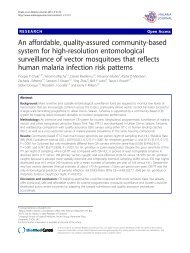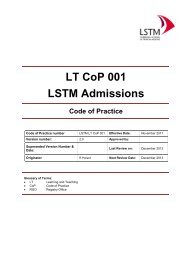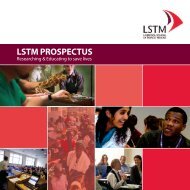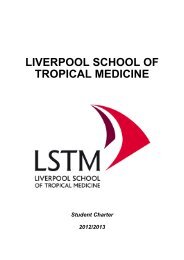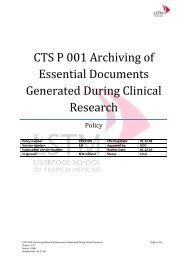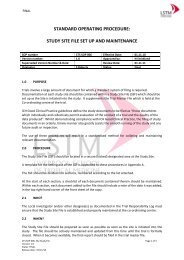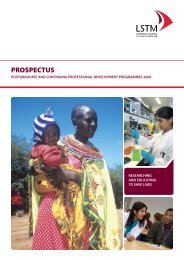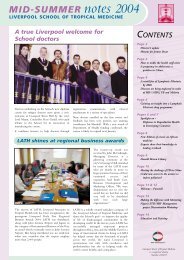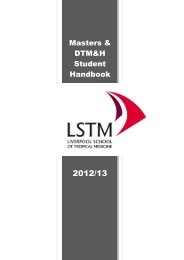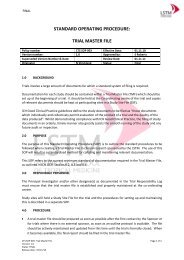Annual Report 2008 - 2009 - Liverpool School of Tropical Medicine
Annual Report 2008 - 2009 - Liverpool School of Tropical Medicine
Annual Report 2008 - 2009 - Liverpool School of Tropical Medicine
Create successful ePaper yourself
Turn your PDF publications into a flip-book with our unique Google optimized e-Paper software.
Rural farming increases risk <strong>of</strong> snakebite Bleeding typical <strong>of</strong> saw-scaled viper envenoming Disability: a common consequence <strong>of</strong> snakebite<br />
“Over 25,000 vials <strong>of</strong> these antivenoms have been delivered free to<br />
snakebite victims in Nigeria in the past 4 years – representing 12,500<br />
treatments against snakebite which, if untreated, kills 20% <strong>of</strong> victims.”<br />
Being bitten by a snake is a daily hazard<br />
for many people living in rural, subsistence<br />
agricultural communities in West Africa. Tilling<br />
the soil by hand exposes farmers to venomous<br />
snakes, particularly in the rainy season when<br />
snakes are driven above ground. Footwear<br />
that might <strong>of</strong>fer protection from snakebite is<br />
either unaffordable or too uncomfortable and<br />
in the dry season, storage <strong>of</strong> seed and crops<br />
attracts rodents, which in turn attract snakes.<br />
The typical location <strong>of</strong> homes near to farms and<br />
grain stores consequently increases domestic<br />
exposure to snakebite, especially in children. It is<br />
estimated that 18,500 West Africans are killed by<br />
the haemorrhagic or neurotoxic effects <strong>of</strong> snake<br />
envenoming each year.<br />
Farmers, typically young adults and children, are<br />
most <strong>of</strong>ten bitten on the feet, lower legs and<br />
hands, critical to a subsistence farmer. Those<br />
surviving the bite will <strong>of</strong>ten suffer from secondary<br />
infections and other severe complications that<br />
too <strong>of</strong>ten can only be resolved by amputation. As<br />
well as the obvious personal consequences, it is<br />
not uncommon for snakebite victims to occupy<br />
the majority <strong>of</strong> hospital beds, placing a significant<br />
and largely unrecognised financial burden on<br />
local health centres.<br />
Antivenom is the only effective therapy and<br />
is prepared from antibodies generated in<br />
horses or sheep which have been immunised<br />
with venom. Africa is reliant exclusively upon<br />
commercially-produced antivenom and the<br />
expense <strong>of</strong> manufacture and cost to the<br />
patient (currently $300 per treatment) reduced<br />
governmental demand to the point where, in<br />
the late 1990s, antivenom ceased to be supplied<br />
to West Africa, with a consequent dramatic rise<br />
in snakebite-induced death and morbidity.<br />
A collaboration to address this crisis, the EchiTab<br />
Study Group, Chaired by Pr<strong>of</strong>essor Theakston,<br />
was formed between the Nigerian Federal<br />
Ministry <strong>of</strong> Health and LSTM. Funded by the<br />
Nigerian Ministry <strong>of</strong> Health and co-ordinated<br />
by the Venom Research Unit, the scheme was<br />
established with the importation <strong>of</strong> some<br />
<strong>of</strong> Nigeria’s most medically important snake<br />
species into the LSTM herpetarium. Venoms<br />
extracted from the snakes by Mr Rowley were<br />
sent to antivenom manufacturers in Wales and<br />
Costa Rica. Utilising newly developed costefficient<br />
techniques, monospecific EchiTab<br />
(effective against saw-scaled viper envenoming)<br />
and polyspecific EchiTabPlus-ICP (effective<br />
against saw-scaled viper, puff adder and<br />
spitting cobra bites) antivenoms have been<br />
manufactured and demonstrated to be safe and<br />
effective in double-blind clinical trials supervised<br />
by Pr<strong>of</strong>essor Warrell, Oxford University.<br />
The EchiTAb Study Group is now focused<br />
upon expanding the delivery <strong>of</strong> these vital<br />
medical supplies and devising systems to<br />
ensure a secure supply <strong>of</strong> safe, effective and<br />
affordable antivenoms to reduce this high<br />
death toll amongst some <strong>of</strong> West Africa’s most<br />
disadvantaged communities. An important<br />
lesson learned while resolving this West African<br />
antivenom crisis was that a stable supply <strong>of</strong><br />
antivenom for Africa is unlikely until there is<br />
sufficient governmental demand to re-stimulate<br />
commercial production and when antivenoms<br />
are affordable to the patient. The objectives <strong>of</strong><br />
the Venom Research Unit research activities are<br />
consequently to develop novel antivenoms that<br />
are effective, safe and cheap.<br />
Drs Harrison and Wagstaff are conducting<br />
venom gland gene surveys <strong>of</strong> all the medically<br />
important snakes in West Africa and analysing<br />
this data, using complex bioinformatic<br />
techniques, to construct synthetic proteins.<br />
These synthetic proteins are carefully designed<br />
to generate antibodies that will neutralise all the<br />
toxins in venoms <strong>of</strong> all the medically important<br />
snakes <strong>of</strong> West Africa. Such a universallyeffective<br />
antivenom should improve demand,<br />
thereby increasing commercial manufacturing<br />
incentives and ultimately driving down the cost<br />
to the patient.<br />
Since camel antibodies are less immunogenic<br />
than those currently used to make antivenom,<br />
Dr Harrison and Mr Cook are investigating<br />
whether they are less likely to induce the serum<br />
sickness and anaphylactic adverse effects<br />
associated with many conventionally-prepared<br />
antivenoms.<br />
As camel antibodies are also more<br />
thermostable, the Venom Research Unit is<br />
testing whether camel antivenoms can be<br />
stored at room temperature, potentially greatly<br />
improving antivenom delivery to many African<br />
regions without electricity.<br />
LSTM ANNUAL REPORT 25



